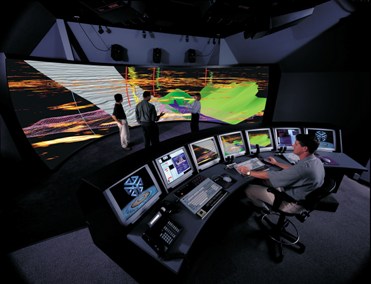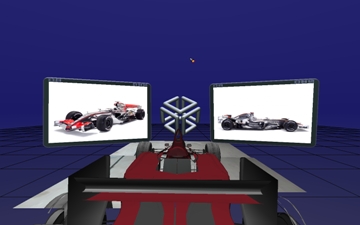This week SGI has announced a new product portfolio that signifies the company’s return to their computer graphics roots. The VUE family of applications is a new lineup of software and services that the company says will change the way you create, distribute and use visual information.
Silicon Graphics, Inc., the company today known as SGI, wasn’t just a computer graphics company: in the mid 80s and early 90s, they were the computer graphics company. SGI invented many of the fundamental hardware technologies and software approaches that grew into the modern graphics card and GPU business. As graphics cards slipped into the commodity market, driven by the massive popularity of computer gaming, SGI found itself in the position of trying to sell graphics workstations for tens of thousands of dollars in a market that could get the same performance from a sub-$1,000 card. By 2005 they had effectively abandoned the graphics business to focus on high performance computing.
SGI did manage to preserve at least some of that graphics expertise deep in the bowels of the company. Soon after Bo Ewald’s return to the company as CEO in April of last year, he was out in public talking about the company’s eventual return to graphics.
In fact, Ewald had already asked Robert Pette, currently vice president of the Silicon Graphics Visualization Group at SGI, but then in charge of professional services for the company, to revaluate the company’s decision to move away from its graphics roots under the leadership of Dennis McKenna and Bob Bishop. During those years Pette says that SGI managed to keep the graphics flame alive at the company within the professional services organization, building custom reality centers for well-heeled clients around the world.
SGI has identified three problems that they feel users face with respect to managing and understanding large amounts of data. In the scientific space, computational models are larger and more complex. The availability of larger supercomputers means that, while yesterday’s large model might have been solved with a 100,000 triangle mesh, today that mesh could well be over 1 billion triangles, and that number will continue to grow. Users need visualization solutions that will scale to these very large sizes.
Second, large data consumers are often a part of global teams, both in scientific and industrial computing organizations, and in organizations that aren’t traditionally compute-intensive but are increasingly data driven — for example, the media industry. Users in these organizations are struggling to enable true collaboration over long distances, but are challenged to work together when everyone cannot simply huddle around the monitor and figure out what’s going on.
Finally, SGI points to information overload as a characteristic of our society, pointing to studies like the one from IDC last year, which estimated the amount of digital data created in 2006 to be 161 exabytes. The same study estimated the amount of digital data would grow to 988 exabytes by 2010, with only 600 exabytes of storage available worldwide. If these numbers are even in the ballpark, we’ll have to do a lot of analysis on the fly, making decisions and losing the original data with tools built to support large scale streams of transient data.
SGI sees a market opportunity in all of this data and, according to Pette, the company’s goal is to enable customers to “visualize anything anywhere, at any time, on any device.” Rather than trying to simply recreate their hardware past, they are focusing on the software side of the solution with this latest offering, the Visual User Experience, or VUE, lineup of software.
The centerpiece of the VUE system is RemoteVUE, a piece of software designed to go out and collect source pixels from video sources or applications running on remote computers, centralize them, and then feed them back out to clients over the network. Pixels are converted to packets via a piece of software that runs on remote machines running applications of interest, with no changes necessary to those applications.
RemoteVUE acts like a big software multiplexor, ingesting source streams of pixels and transforming them to a format appropriate for a particular user’s endpoint device. A user watching a high definition NBA feed on a VUE-connected high-def display needs all those pixels, but another user watching the same feed at the same time on his BlackBerry needs far fewer pixels, and probably needs a highly compressed feed as well to compensate for the slower network connection. RemoteVUE handles all the mixing and matching of sources and displays, sending just what is needed for each client.
The legacy of RemoteVUE is SGI’s Vizserver application, the remote visualization solution from several years ago. That solution was plagued with problems and never achieved broad use. Pette says that SGI only used pieces of that software in the new product, and that major portions have been rewritten to support better encryption, compression and stream encoding algorithms. According to Pette,”RemoteVUE picks up where Vizserver left off.”
While RemoteVUE is the centerpiece of the VUE system, FusionVUE is the centerpiece of the user experience. FusionVUE creates a three dimensional environment into which any visual stream of data available to the user can be combined to create an information synthesis environment. I’ve heard a moderately compelling argument for this in which multiple aspects of a computational simulation are brought together into one VUEspace for team collaboration. For example, a mechanical simulation running on the East Coast, and a thermodynamic simulation running in Europe can be brought into one space and then distributed to the teams on both sides of the Atlantic, enabling everyone to see the whole picture.
The most compelling demonstrations I’ve seen, however, are command-and-control types of applications. The canonical example of this is the intelligence analyst hunched in front of an expansive display looking at a virtual representation of some region of the world dotted with live video feeds, streams of intelligence data, and conventional news sources that, together, convey a deeper understanding of some dire set of circumstances about to unfold. I got to see a more fun example a couple of weeks ago when an SGI engineer showed me a VUEspace built around an NBA court. The VUEspace placed live video feeds on virtual televisions on the court showing what the cameras at those locations were seeing of the game. Just clicking on any of those cameras would show you a full screen view of the action from that perspective. With the right support on the application end (added via the VUE API), users can even interact with the applications in the FusionVUE environment just as though they were running natively on their own desktop.
A key selling point of FusionVUE is meant to be that the system provides an interface simple enough for most people to go in and, with minimal training, build analysis scenarios that bring together as many feeds as they need in an intuitive environment of their own creation. My feeling from early experiences with the software is that it is still early days for FusionVUE, and that it will take the company a few more iterations to get to that point.
Pette says that a key drawback of the modern crop of GPUs is that the amount of memory available to them makes rendering of large datasets slow, and although memory on GPUs will undoubtedly continue to increase, so too will the size of data being analyzed. SGI’s solution to this is two pieces of software, PowerVUE and SoftVUE, both aimed at software rendering support on the CPU. SGI feels that, as the number of cores in CPUs continue to increase, the larger memory available to CPUs and the elimination of bus traffic needed to get data back and forth from a graphics card will make CPUs a much more attractive option for the real-time rendering of large data.
PowerVUE and SoftVUE aren’t quite as far along as other pieces of the VUE lineup, but when complete will support software rendering on large-scale servers (think Altix) and desktop machines. This approach also happens to fit nicely into the business model of one of SGI’s key partners, Intel, with whom SGI is collaborating on bringing the entire VUE lineup to market. The fifth component of the lineup, EventVUE, is mentioned in the release as “giving decision-makers a 360-degree view of complex events while avoiding information overload,” but this particular piece is not being discussed at this time. RemoteVUE is expected before the end of this year, with FusionVUE expected for release in the first quarter of 2009. Both SoftVUE and PowerVUE are expected in the second quarter of next year.
How will SGI bring VUE to market? Pette says that he’d like to see a broad path to market for the entire VUE suite through a combination of partners and OEMs, who would integrate the technology in everything from conference room systems to complex command and control environments. SGI is also exploring a direct sales path for parts of the suite, but getting picked by an appliance vendor who can move large amounts of product while feeding licensing fees back to SGI would clearly be a home run for the company, and it’s easy to guess that’s the preferred road to market here.
What to make of SGI’s grab for a piece of its old pixellated glory?
Computer graphics hardware has continued to develop rapidly on the desktop, and both major chip vendors have incorporated GPUs into their business strategy going forward. SGI is both relying on these advances and, through its PowerVUE and SoftVUE investments, developing insurance against the future collapse of the specialized graphics processor back into the CPU.
Companies have been trying to share pixels from one place to another for decades, and nothing (from shared X-displays to Vizserver itself to PC-based video chat) has caught on in a significant way. I think that a key reason for the slow uptake is that the reason people want to share pixels — to work, play, or interact naturally with someone not local to them — is fundamentally hard when the experience is mediated by a computer. This fact, combined with the mechanical difficulties that arise with today’s still-clunky solutions, has slowed the acceptance of remote collaboration solutions.
Using VUE to overcome these mechanical hurdles might allow SGI to bring enough new, creative people into the space that the collaboration-at-a-distance problem can finally be solved. This would lead to a windfall for the company selling the pieces that finally make good on the promise of cooperation at a distance.



























































